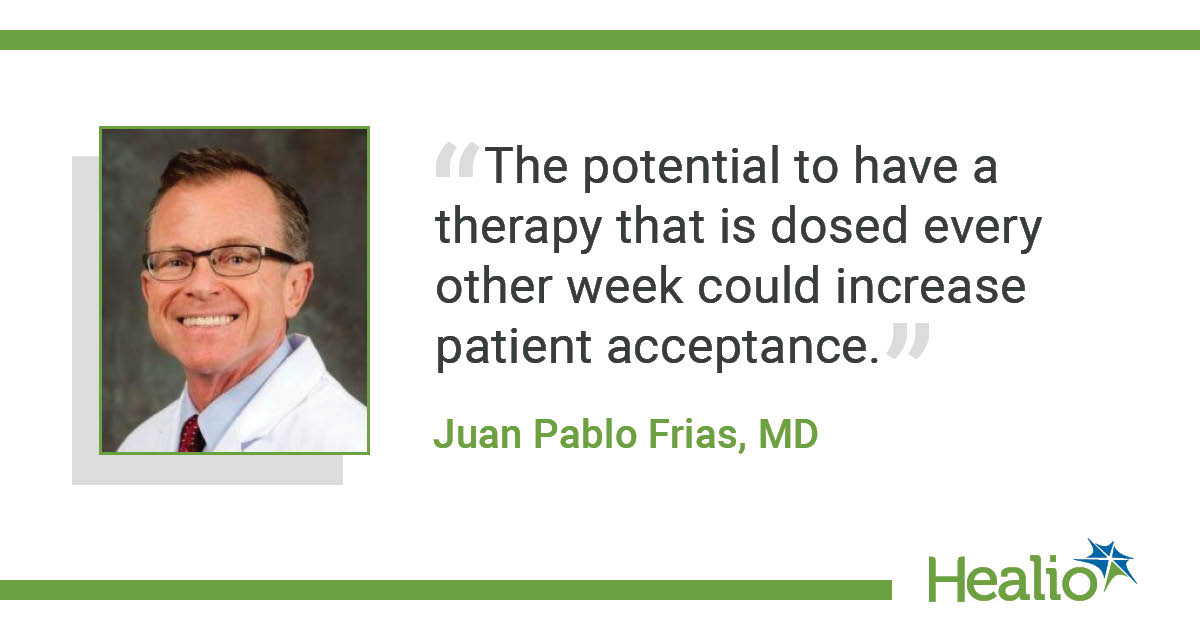BIO89-100 reduces liver fat, lowers triglycerides in adults with NASH – Healio
Frias JP, et al. BIO89-100 demonstrated robust reductions in liver fat and liver fat volume (LFV) by MRI-PDFF, favorable tolerability and potential for weekly (QW) or every 2 weeks (Q2W) dosing in a phase 1b/2a placebo-controlled, double-blind, multiple ascending dose study in NASH. Presented at: ENDO annual meeting; March 20-23, 2021 (virtual meeting).
Frias JP, et al. BIO89-100 demonstrated robust reductions in liver fat and liver fat volume (LFV) by MRI-PDFF, favorable tolerability and potential for weekly (QW) or every 2 weeks (Q2W) dosing in a phase 1b/2a placebo-controlled, double-blind, multiple ascending dose study in NASH. Presented at: ENDO annual meeting; March 20-23, 2021 (virtual meeting).
BIO89-100 reduced liver fat in adults with nonalcoholic steatohepatitis, or NASH, while also lowering triglycerides for participants taking weekly and biweekly doses, according to trial data presented at the ENDO annual meeting.
“In patients with NASH, BIO89-100 has been shown to significantly decrease liver fat and liver volume as well as to have beneficial effects on common metabolic comorbidities, such as type 2 diabetes and hypertriglyceridemia,” Juan Pablo Frias, MD, medical director and principal investigator at the National Research Institute in Los Angeles, told Healio. “In addition, it is well tolerated with a gastrointestinal side effect profile similar to placebo in this study.”
Frias and colleagues conducted a double-blind, placebo-controlled, phase 1B/2A trial with participants with biopsy-proven or phenotypic NASH and MRI-proton density fat fraction of 10% or greater. Participants were randomly assigned to placebo or BIO89-100 (89bio), a long-acting glycopegylated fibroblast growth factor 21 analog, for 12 weeks. Those receiving BIO89-100 were randomly assigned to a 3 mg, 9 mg, 18 mg or 27 mg dose weekly, or an 18 mg or 36 mg dose every 2 weeks. Treatment lasted for 12 weeks and was followed by a 4-week safety follow-up.
All BIO89-100 treatment groups had significant reductions in liver fat at 13 weeks, with placebo-corrected relative reductions ranging from 46% to 70% (P < .001 for all). Across the groups, 60% to 88% of participants achieved the clinically meaningful target of a 30% or greater relative reduction in liver fat. Liver fat volume also decreased in all six BIO89-100 groups, with the 27 mg weekly dose subgroup having the greatest reduction at 65% (P < .001).
BIO89-100 lowered triglyceride levels by 18% or more in all six treatment groups. In a subgroup of 15 participants with baseline triglycerides of at least 200 mg/dL, triglycerides were reduced by 33% to 49%, and 53% of these participants had normal triglyceride levels at week 13 (< 150 mg/dL).
There were 17 BIO89-100 recipients with high alanine aminotransferase levels of 45 U/L at baseline and five with high ALT levels in the placebo group. The BIO89-100 participants had a larger decrease in ALT levels at week 13 when compared with placebo (–35 U/L vs. –10.3 U/L, P < .05).
Metabolic markers were also assessed, and the 27 mg per week dose demonstrated improvements in glucose homeostasis and insulin sensitivity as well as a 65% placebo-adjusted increase in plasma adiponectin concentrations.
Participants in the BIO89-100 group had a lower prevalence of diarrhea compared with placebo (9.5% vs. 11.1%) as well as a lower prevalence of nausea (4.8% vs. 11.1%). Only two serious adverse events were reported, and both were COVID-19 infections not connected with the treatment.
“NASH is a chronic disease and patients are generally asymptomatic until late in the disease course,” Frias said. “The potential to have a therapy that is dosed every other week could increase patient acceptance as well as adherence and persistence with therapy.”
More studies are planned to further examine the effects of BIO89-100. Researchers are currently conducting an open-label cohort study involving participants from phase 1B/2A to examine the histology of patients with NASH. Frias said the study will give researchers insight on how BIO89-100 affects fibrosis caused by NASH.
“The company expects to initiate a phase 2b NASH study in the first half of this year to build on the results of these data,” Frias said. “There is also an ongoing phase 2 study in patients with severe hypertriglyceridemia, a condition that shares some of the same metabolic comorbidities as NASH.”
Peter Goulden, MD, FRCP
Nonalcoholic steatohepatitis affects an estimated 5% of adults in the U.S. Lifestyle interventions are crucial and include weight loss, physical activity and abstaining from alcohol. For patients with NASH in combination with diabetes, pioglitazone and liraglutide have shown benefit in several trials.
In this phase 1b/2a trial, a study of a novel agent, BIO89-100 (a glycoPEGylated FGF21 compound), was reported at the Endocrine Society’s annual meeting in 2021; BIO89-100 significantly reduced liver fat and volume along with a concurrent reduction in triglycerides.
A phase 2b trial of BIO89-100, ENLIVEN is expected to begin soon and will test the efficacy and safety of a liquid form of the agent, looking at histology-based endpoints of NASH resolution and improvements in fibrosis.
The study size was small at just 81 patients, and they had liver fat of 10% measured by MRI proton density fat fraction (MRI-PDFF). Eighty-eight percent of patients treated with the drug showed a 30% reduction minimum in MRI-PDFF (P < 0.001). These findings are intriguing given the prevalence of NASH and its potential progression to hepatic cirrhosis. The ENLIVEN trial will be vital in investigating this novel agent further. ENLIVEN will be a multicenter, randomized, double blind, placebo-controlled phase 2b study designed to evaluate the safety and efficacy of BIO89-100 in biopsy-confirmed NASH patients with fibrosis stage 2 or 3, and many will be waiting for the results with great interest.
Get the latest news and education delivered to your inbox
© 2022 Healio All Rights Reserved.
Get the latest news and education delivered to your inbox
© 2022 Healio All Rights Reserved.






